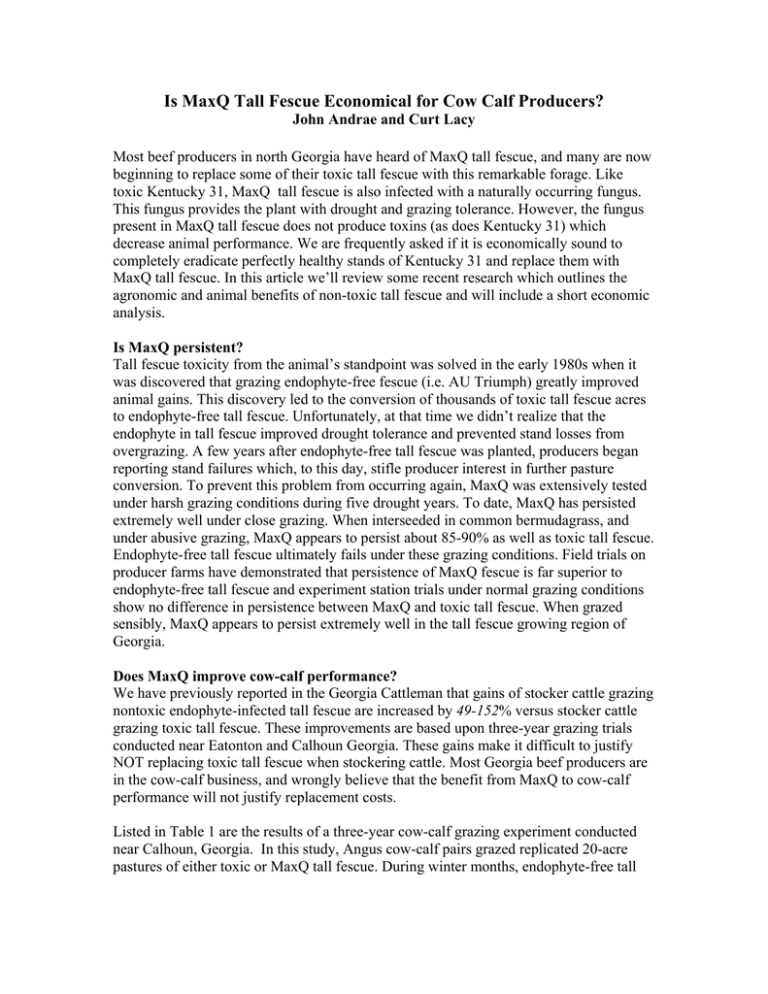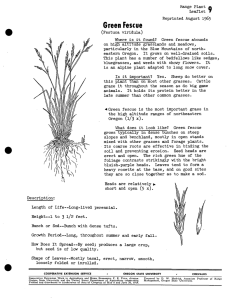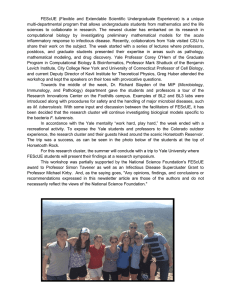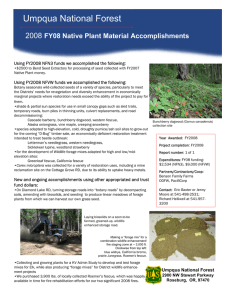Is MaxQ Tall Fescue Economical for Cow Calf Producers?
advertisement

Is MaxQ Tall Fescue Economical for Cow Calf Producers? John Andrae and Curt Lacy Most beef producers in north Georgia have heard of MaxQ tall fescue, and many are now beginning to replace some of their toxic tall fescue with this remarkable forage. Like toxic Kentucky 31, MaxQ tall fescue is also infected with a naturally occurring fungus. This fungus provides the plant with drought and grazing tolerance. However, the fungus present in MaxQ tall fescue does not produce toxins (as does Kentucky 31) which decrease animal performance. We are frequently asked if it is economically sound to completely eradicate perfectly healthy stands of Kentucky 31 and replace them with MaxQ tall fescue. In this article we’ll review some recent research which outlines the agronomic and animal benefits of non-toxic tall fescue and will include a short economic analysis. Is MaxQ persistent? Tall fescue toxicity from the animal’s standpoint was solved in the early 1980s when it was discovered that grazing endophyte-free fescue (i.e. AU Triumph) greatly improved animal gains. This discovery led to the conversion of thousands of toxic tall fescue acres to endophyte-free tall fescue. Unfortunately, at that time we didn’t realize that the endophyte in tall fescue improved drought tolerance and prevented stand losses from overgrazing. A few years after endophyte-free tall fescue was planted, producers began reporting stand failures which, to this day, stifle producer interest in further pasture conversion. To prevent this problem from occurring again, MaxQ was extensively tested under harsh grazing conditions during five drought years. To date, MaxQ has persisted extremely well under close grazing. When interseeded in common bermudagrass, and under abusive grazing, MaxQ appears to persist about 85-90% as well as toxic tall fescue. Endophyte-free tall fescue ultimately fails under these grazing conditions. Field trials on producer farms have demonstrated that persistence of MaxQ fescue is far superior to endophyte-free tall fescue and experiment station trials under normal grazing conditions show no difference in persistence between MaxQ and toxic tall fescue. When grazed sensibly, MaxQ appears to persist extremely well in the tall fescue growing region of Georgia. Does MaxQ improve cow-calf performance? We have previously reported in the Georgia Cattleman that gains of stocker cattle grazing nontoxic endophyte-infected tall fescue are increased by 49-152% versus stocker cattle grazing toxic tall fescue. These improvements are based upon three-year grazing trials conducted near Eatonton and Calhoun Georgia. These gains make it difficult to justify NOT replacing toxic tall fescue when stockering cattle. Most Georgia beef producers are in the cow-calf business, and wrongly believe that the benefit from MaxQ to cow-calf performance will not justify replacement costs. Listed in Table 1 are the results of a three-year cow-calf grazing experiment conducted near Calhoun, Georgia. In this study, Angus cow-calf pairs grazed replicated 20-acre pastures of either toxic or MaxQ tall fescue. During winter months, endophyte-free tall fescue hay was fed to cows on all pastures. Both MaxQ and toxic tall fescue pastures had an average stocking rate of 1.1 acres per cow. Table 1. Three-year performance of cow-calf pairs grazing either MaxQ or toxic tall fescue near Calhoun, GA. Adapted from J.H. Bouton, 2003 American Forage and Grassland Council Proceedings. Lafayette, LA. MaxQ tall fescue Toxic tall fescue Brood cows: Calving rate, % 89 90 Average daily gain, lbs 0.59 0.17 Condition score change 0.6 0.3 Calves: Steer weaning wt., lbs 575 509 Heifer weaning wt, lbs 525 481 If anything, the reported calving rate of cows grazing toxic tall fescue are overly optimistic. It is likely that feeding endophyte-free hay during the breeding season in the Calhoun study may have offset some of the negative reproductive effects of toxic pastures. Cattle grazing toxic tall fescue normally have 20-30% decreased conception rates versus non-toxic endophyte-free tall fescue. Many cattlemen in the tall fescue region do not realize this negative reproductive effect is occurring due to the lack of a controlled breeding season. Cows are allowed to rebreed over an entire calendar year, and may eventually rebreed after remaining open for many months. Cows grazing MaxQ tall fescue had significantly higher average daily gains and body condition scores. This should translate to increased reproductive efficiency over long periods. Calf weaning weight responses to MaxQ tall fescue were impressive. Over a three-year period, there was a 66 and 44 pound advantage for steer and heifer weaning weights. A 55 pound overall increase in weaning weights will pay for a lot of seed and management, particularly when calf prices exceed $1.00 per pound. Replacing toxic tall fescue with MaxQ. MaxQ tall fescue should be established in an area that is free of living toxic tall fescue plants. Following a soil test to determine if potash, phosphate or lime is needed, a spraysmother-spray procedure is typically followed. Using this procedure, a field of tall fescue is killed with glyphosate prior to spring seed production. The field is then no-till planted with pearl millet which serves to smother the surviving toxic tall fescue plants. This pearl millet can be grazed or hayed during the summer. In September, the pearl millet stubble and surviving tall fescue is sprayed with another application of glyphosate and the area can be planted with 20-25 pounds per acre of MaxQ. Do not graze MaxQ seedlings until they reach 8” in height and graze lightly to allow an adequate root system to form for summer survival during the establishment year. Research is underway to determine if a shorter procedure can be developed for replacing toxic tall fescue. I will update the Georgia Cattleman as soon as this data is summarized. Will it pay to replace toxic tall fescue with Max-Q? MaxQ will increase performance and improve calving rates, but will it pay to replace a good stand of toxic tall fescue with MaxQ? As with any long-term investment decision, we must consider two things: are the annual net returns with MaxQ greater than with toxic tall fescue, and if so will these additional net returns cover the investment costs? Net returns from grazing MaxQ Using the numbers from Table 1, we see that cows grazed on MaxQ wean heavier calves than those grazing toxic tall fescue. If we adjust the sales prices for heaver weights, annual net returns over variable costs (ROVC) for MaxQ exceed those for toxic tall fescue as Shown in Table 2. These ROVC take into consideration the slightly higher annual costs for MaxQ ($4.00 per acre) and are figured at the stocking rate of 1.1 acres per cow. Table 2 Returns over Variable Costs, Returns over Variable and Establishment Costs, and Years to Recover Establishment Costs at Various Calving Rates of Toxic Tall Fescue Calving Rate on Toxic Tall Fescue 90% 80% 75% 66% Returns Over Variable Costs Per Cow Per Year $ $ $ $ 18.70 55.39 73.74 106.76 Returns Over Variable and Establishment Costs Per Cow Per Year $ (0.90) $ 35.79 $ 54.14 $ 87.16 Years to Breakeven 10.5 3.5 2.7 1.8 At a 90% calving percentage, MaxQ generates positive returns over variable costs but does not quite cover the cost of establishment. However, as was stated previously, calving percentages are usually severely impacted by grazing toxic fescue. If we take into consideration the likely possibilities of 66-80 percent calf crops, we can see MaxQ generates considerable net returns, anywhere from $55 to $107 above variable expenses and from $36 to 87 including the cost of establishment, when compared to toxic tall fescue. For a herd of 35 cows this is between $1,895 and $3,050 per year. Years to pay for MaxQ Since MaxQ is not cheap to establish, almost $200 per acre considering, chemicals, seed, labor, and lost grazing; many producers are curious to know how many years of grazing they need to recoup their investment. The column “Years to Breakeven” in Table 2 addresses this question. If there is no difference in calving percentages, it takes almost 11 years to recover the investment cost of MaxQ. However, when we use a more realistic numbers 75 percent calf crop, we see that MaxQ pays for itself in less than three years. Obviously, the larger the differences in calving percentages, the quicker MaxQ will pay for itself. Summary MaxQ is a very promising piece of forage technology. Grazing trials conducted in central and north Georgia have shown its’ positive effects on stocker gains and calf weaning weights. Economic analysis has shown that replacing toxic tall fescue with MaxQ would be a very wise move for many producers. For more information on replacing toxic tall fescue with MaxQ contact your local extension office. You may also want to get a copy of the UGA Extension Publication “Novel-Endophyte Infected Tall Fescue”. This publication is available through your local extension office or can be downloaded from the World Wide Web at www.georgiaforages.com.




